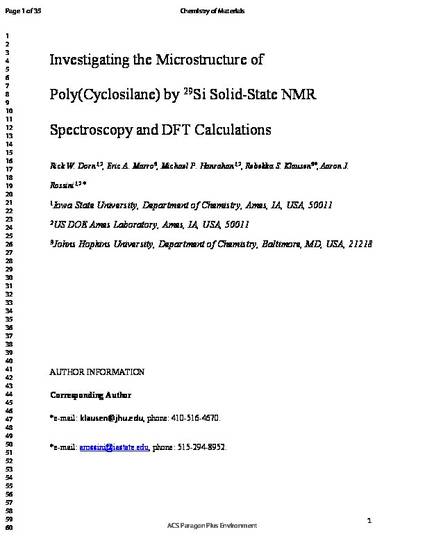
Using high-resolution magic-angle spinning (MAS) solid-state NMR spectroscopy and density-functional theory (DFT) calculations, we determine the microstructure of the silicon-based functional polymer poly(1,4Si6) arising from the dehydrocoupling polymerization of cyclosilane 1,4Si6. 1H-29Si refocused-INEPT experiments allow the unambiguous determination of the number of attached protons to a silicon atom for each 29Si signal in 1,4Si6 and poly(1,4Si6). One-dimensional 1H→29Si cross-polarization MAS (CPMAS) spectra of poly(1,4Si6) show the development of SiH resonances upon polymerization and peak integration indicates an average degree of polymerization of 20. The 1H→29Si CPMAS spectrum of poly(1,4Si6) also shows two sets of isotropic signals, suggesting the presence of at least two distinct species. Two-dimensional 29Si dipolar double-quantum-single-quantum and single-quantum-single-quantum homonuclear correlation spectra reveal similar connectivity in the two species, pointing to stereochemical and/or conformational heterogeneity. DFT calculations on trimer models predict that chair or twist-boat conformations and with cis or trans diastereomers are all energetic minima. 29Si chemical shift calculations of the lowest energy structures show that conformers and stereoisomers are expected to give rise to distinct 29Si NMR peaks and likely explain the appearance of multiple sets of 29Si NMR signals. The strategy outlined here is expected to be widely useful for the microstructural elucidation of silicon-based functional polymers.
Available at: http://works.bepress.com/aaron-rossini/66/

This document is the unedited Author’s version of a Submitted Work that was subsequently accepted for publication in Chemistry of Materials, copyright © American Chemical Society after peer review. To access the final edited and published work see DOI: 10.1021/acs.chemmater.9b03606. Posted with permission.